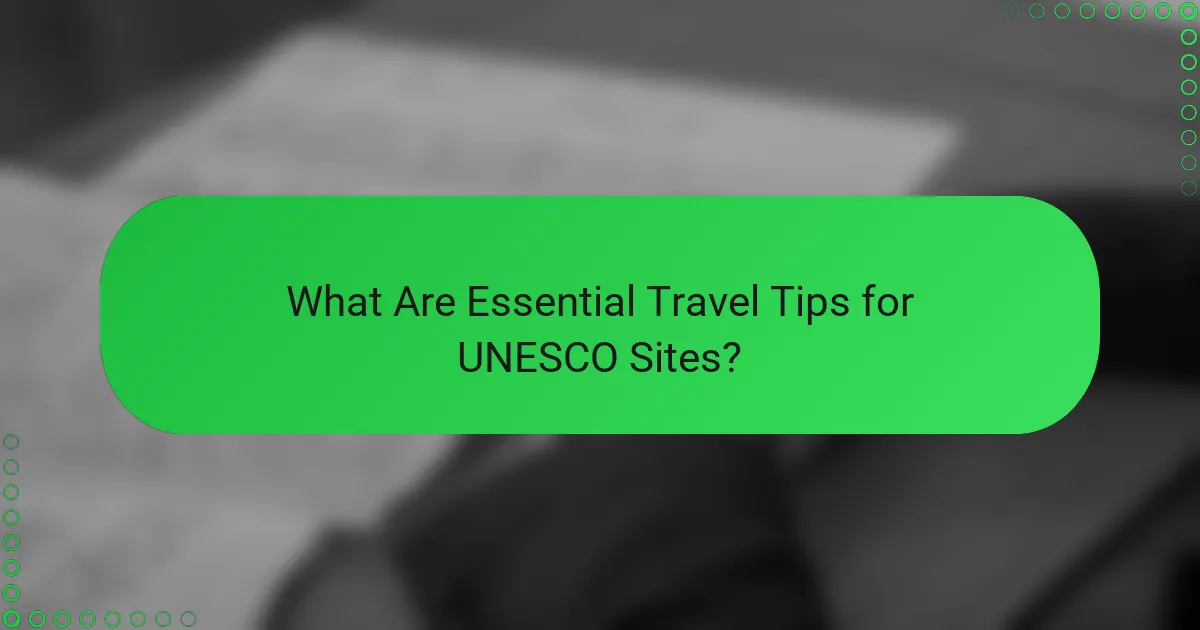Discovering UNESCO hidden cultural sites offers travelers a chance to immerse themselves in rich history and stunning architecture, often away from the bustling tourist crowds. These unique destinations provide authentic insights into diverse cultures and traditions, making them essential stops for any adventurous traveler. To make the most of your visit, it’s important to understand local regulations, respect customs, and prepare adequately for the environment.

What Are the Best UNESCO Hidden Cultural Sites to Visit?
The best UNESCO hidden cultural sites to visit offer unique experiences that showcase rich history and stunning architecture, often away from the typical tourist crowds. Exploring these locations provides insight into diverse cultures and traditions, making them worthwhile destinations for travelers seeking authenticity.
Angkor Wat, Cambodia
Angkor Wat is the largest religious monument in the world and a stunning example of classical Khmer architecture. This UNESCO site, originally built in the early 12th century, is renowned for its intricate carvings and vast temple complex, making it a must-see for history enthusiasts.
When visiting, consider timing your trip for sunrise or sunset to avoid the heat and capture breathtaking photographs. Be mindful of local customs, such as dressing modestly when entering temple areas.
Hampi, India
Hampi, a UNESCO World Heritage Site, is famous for its ancient ruins and unique boulder-strewn landscape. Once the capital of the Vijayanagara Empire, it features impressive temples, palaces, and marketplaces that reflect its historical significance.
To fully appreciate Hampi, plan to spend several days exploring its vast area. Renting a bicycle can be an effective way to navigate between sites, and visiting during the cooler months from October to March is advisable for a more comfortable experience.
Matera, Italy
Matera is known for its ancient cave dwellings, called Sassi, which have been inhabited for thousands of years. This UNESCO site offers a glimpse into a unique way of life and stunning views of the surrounding landscape.
When visiting Matera, take time to wander through its narrow streets and enjoy local cuisine, such as the famous bread from Matera. Consider staying overnight to experience the town’s charm after day-trippers leave.
Rani Ki Vav, India
Rani Ki Vav is an intricately designed stepwell located in Gujarat, India, and recognized as a UNESCO World Heritage Site. Built in the 11th century, it showcases stunning sculptures and carvings that depict various deities and mythological scenes.
Visiting Rani Ki Vav is best done in the cooler months, and it’s advisable to hire a local guide to gain deeper insights into its historical context and architectural significance.
Old City of Dubrovnik, Croatia
The Old City of Dubrovnik, a UNESCO World Heritage Site, is celebrated for its well-preserved medieval architecture and stunning coastal views. Known as the “Pearl of the Adriatic,” it features impressive city walls and historic buildings that tell the story of its rich past.
To make the most of your visit, explore the city early in the morning or late in the evening to avoid crowds. Don’t miss the chance to walk along the city walls for panoramic views of the Adriatic Sea and the surrounding area.

How to Plan Your Visit to UNESCO Hidden Cultural Sites?
Planning your visit to UNESCO hidden cultural sites involves understanding local regulations, choosing the best times to visit, and securing appropriate travel insurance. These steps ensure a smooth and enriching experience while exploring these unique destinations.
Research Local Regulations
Before visiting UNESCO hidden cultural sites, familiarize yourself with local regulations that may affect your trip. Some sites may have restrictions on photography, visitor numbers, or specific dress codes that reflect cultural sensitivities.
Check if permits are required for entry or if there are designated visiting hours. For example, certain sites in countries like Bhutan or Indonesia may have limited access to preserve their integrity.
Best Times to Visit
The best times to visit UNESCO hidden cultural sites often depend on the region’s climate and peak tourist seasons. Generally, spring and fall offer milder weather and fewer crowds, making for a more enjoyable experience.
For instance, visiting the ancient city of Petra in Jordan is ideal from March to May or September to November, when temperatures are more comfortable. Research specific sites to determine optimal visiting months based on local weather patterns.
Travel Insurance Recommendations
Obtaining travel insurance is crucial when visiting UNESCO hidden cultural sites, as it can protect you from unforeseen circumstances such as trip cancellations, medical emergencies, or lost belongings. Look for policies that cover adventure activities if you plan to engage in hiking or exploration.
Ensure your insurance includes coverage for cultural heritage sites, as some policies may have exclusions. Compare different plans to find one that suits your travel needs and offers adequate protection for your itinerary.

What Are Essential Travel Tips for UNESCO Sites?
When visiting UNESCO sites, essential travel tips include understanding local customs, packing appropriately for the environment, and staying hydrated. These practices enhance your experience and ensure respect for the cultural significance of these locations.
Respect Local Customs
Respecting local customs is crucial when visiting UNESCO sites, as these locations often hold deep cultural and historical significance. Familiarize yourself with local traditions, dress codes, and etiquette to show appreciation for the heritage you are experiencing.
For example, in some cultures, modest clothing is required when visiting religious sites. Always observe any signs or guidelines provided at the site, and be mindful of local behaviors, such as greeting practices or photography restrictions.
Pack Appropriately
Packing appropriately for UNESCO sites ensures comfort and readiness for various conditions. Consider the climate and terrain of the location; lightweight, breathable clothing is ideal for warm climates, while layers may be necessary in cooler regions.
Additionally, include essentials such as sturdy walking shoes, a hat, sunscreen, and a reusable water bottle. If you plan to visit remote areas, a small backpack with snacks and a first-aid kit can be beneficial.
Stay Hydrated
Staying hydrated is vital when exploring UNESCO sites, especially in warmer climates or during extensive walking tours. Carry a refillable water bottle to ensure you have access to water throughout your visit.
As a general rule, aim to drink at least two liters of water per day, adjusting for activity level and heat. Be aware of signs of dehydration, such as dizziness or fatigue, and take breaks in shaded areas when needed.

What Are the Unique Features of Each UNESCO Site?
Each UNESCO site possesses distinct characteristics that contribute to its recognition, including architectural styles, cultural significance, and historical context. Understanding these features enhances the travel experience and appreciation of these remarkable locations.
Architectural Styles
UNESCO sites showcase a variety of architectural styles that reflect the cultural and historical influences of their regions. For instance, Gothic cathedrals in Europe exhibit intricate designs and towering spires, while traditional Japanese temples feature wooden structures and serene gardens. These styles often embody the artistic and engineering achievements of their time.
When visiting, pay attention to the details in construction and design, as they often tell stories about the era and the people who built them. Look for unique elements like domes, arches, and decorative motifs that are specific to each site’s architectural heritage.
Cultural Significance
The cultural significance of UNESCO sites lies in their ability to represent the traditions, beliefs, and practices of a community. For example, the ancient ruins of Machu Picchu in Peru symbolize Incan civilization and its connection to nature. Similarly, the Great Wall of China reflects the historical efforts of a society to protect its territory.
Visitors should engage with local guides or cultural programs to gain deeper insights into the traditions associated with each site. This interaction can enhance understanding and appreciation of the cultural narratives that these sites embody.
Historical Context
Understanding the historical context of UNESCO sites is crucial for appreciating their significance. Many sites are linked to pivotal events, such as the signing of treaties or the rise and fall of empires. For instance, the Pyramids of Giza represent the architectural prowess of ancient Egypt and its complex society.
Researching the history of a site before visiting can provide valuable context. Consider exploring local museums or historical documents that offer insights into the events that shaped these locations. This background knowledge can transform a visit into a more enriching experience.

What Are the Costs Associated with Visiting UNESCO Sites?
Visiting UNESCO sites can involve various costs, including entry fees, transportation, and accommodation. These expenses can vary significantly depending on the location and the specific site.
Entry Fees
Entry fees for UNESCO sites can range from free access to several tens of euros or dollars. For example, popular sites like the Acropolis in Greece may charge around €20, while lesser-known sites might have minimal or no fees. Always check the official website for the most current pricing.
Transportation Costs
Transportation costs can vary widely based on the site’s location and your starting point. If you are traveling within Europe, budget airlines or trains can be economical options, often costing between €20 to €100 for a round trip. In more remote areas, consider local transport options like buses or taxis, which may add to your overall expenses.
Accommodation Expenses
Accommodation costs near UNESCO sites can range from budget hostels to luxury hotels. Expect to pay anywhere from €30 per night for basic lodging to over €200 for upscale options. Booking in advance and considering nearby towns can help reduce costs.
Additional Costs
Beyond entry fees, transportation, and accommodation, consider additional costs such as guided tours, food, and souvenirs. Guided tours can enhance your experience but may add €10 to €50 per person. Dining near popular sites can be pricier, so exploring local eateries can be a more budget-friendly choice.


